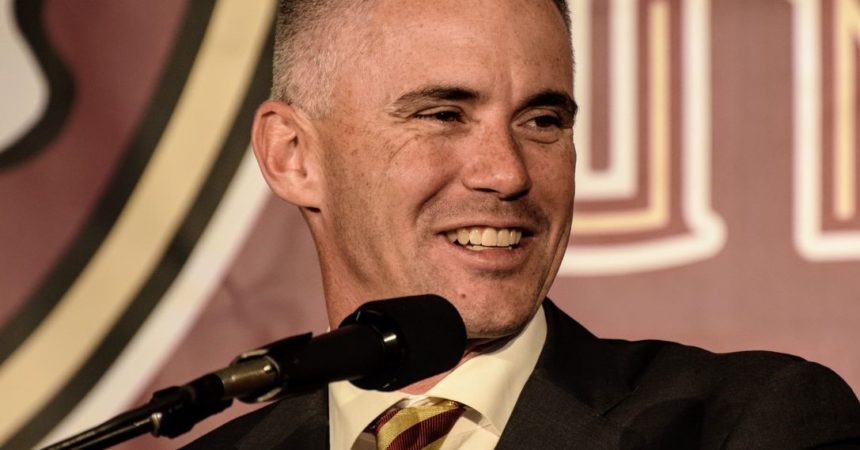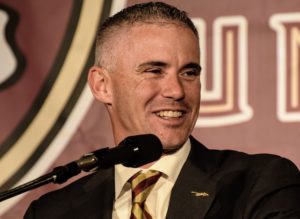
Norvell holds Noles to new standard at ‘tour of duty’
By Tim Linafelt
Senior writer/Seminoles.com
Mike Norvell isn’t yet thinking about depth charts, play calls or anything else related to how the Florida State football team might look when spring practice starts on March 7. To say nothing of the season opener on Sept. 5.
As he darted from station to station during FSU’s pre-dawn “Tour of Duty” – otherwise known as offseason conditioning – there seemed to be only one thing on Norvell’s mind:
These Seminoles are still learning how to work.
And he’s not shy about where things stand as of mid-February.
“I’ll tell you,” he said, “we still have a lot of work to do.”

Coach Mike Norvell is using the off season workouts to get a sense of the role each player will have on the FSU football team.
Photo special to the Outlook
That sentiment seemed to be a theme of Norvell’s 10-minute Q&A with reporters following Thursday’s session.
Yes, there’s visible, tangible progress.
And yes, some players are excelling in their race toward the new benchmark set in place by Norvell and his strength and conditioning staff.
But the Seminoles still have several “Tour of Duty” sessions between now and the start of spring practice, and Norvell is glad to have them all.
“It’s a daily process,” he said. “We talk a lot about not only what we’re doing, but, just as equally important is how we’re doing it. Being able to get the right mindset, the right approach. …
“The standard, the expectation. That’s what I’m looking for.”
The drills themselves might look somewhat familiar to longtime FSU football fans.
Norvell said that they were inspired by the famously challenging “mat drills” that coaches Bobby Bowden and Mickey Andrews put their players through in the 1980s and 90s.
He first became acquainted with them after Todd Graham, whom Norvell worked with at Tulsa, Arizona State and Pittsburgh, visited Tallahassee for an extended look at what made the dynasty-era Seminoles so special.
Some of the details have changed and evolved over the last 30 years, but Norvell said that the overall spirit of what took place on last Thursday morning is aligned with what their championship-winning predecessors did.
“That’s where you get the edge,” Norvell said. “That’s where the mindset and the approach come from. Obviously, we’ve continued to develop what we do and (tailored) the things to this team that we want to see. But the core of it started here.”
For more than an hour, the Seminoles divided into position groups and labored through multiple stations designed to test their athleticism, their strength and their mental fortitude.
The trash cans stationed around the perimeter were both plentiful and put to good use.
Whether working their agility, their speed or their hand-eye coordination, the Seminoles were graded on the way they completed the drill, as well as their attitudes and body language while doing so.
Any player who fell short of the standard quickly found himself dropping to the turf for push-ups.
“We grade everything that we do,” Norvell said.
Quite visibly, in fact.
Norvell and staff have devised a rather public accountability system in which a player wears a jersey that corresponds with how well he’s performing in the Tour of Duty.
Players last Thursday wore a variety of jerseys – orange, white practice, garnet practice, white game and garnet game.
Norvell didn’t specify which jerseys correspond to which performance, but the message was clear: Everyone’s standing is known to everyone else. Nowhere to hide.
And things can change based on a single good or not-so-good workout.
“We put people in jerseys accordingly,” Norvell said.
Any player who reaches the top of that hierarchy will likely form the foundation of the team’s leadership structure come this fall.
But that’s still a long way away, and Norvell gave them impression that he’s just as far from determining any potential locker room leaders.
How could he, when every player on the roster is still learning what it takes to reach his demands on a consistent basis?
“For leadership to emerge, we’ve got to have consistent actions,” he said. “I think leadership will show over time.”
For now, Norvell said that the burden to lead falls solely on himself and his assistant coaches.
And he’s not going to force any player onto an accelerated timeline.
“(Leadership) is going to occur when the words equal the actions,” Norvell said. “Leadership is not about a speech. It’s about consistent action, day in and day out, to the standard.”







